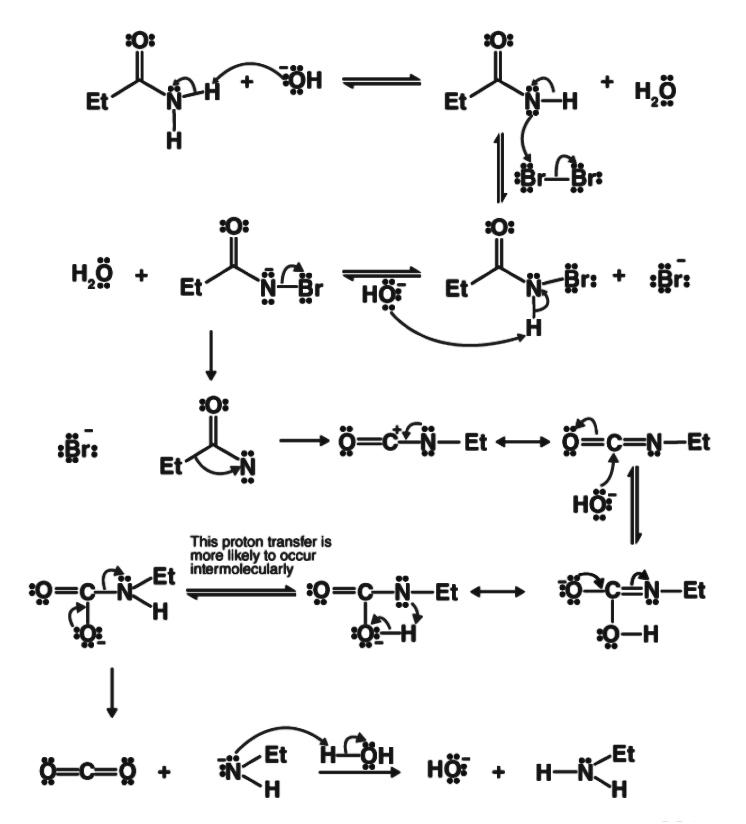
Hofmann's hypobromite reaction affords a method of:
- A. Preparing a tertiary amine
B. Preparing a mixture of amines
C. Stepping down a series
D. Stepping up a series
- A. Preparing a tertiary amine
Answer
221.1k+ views
Hint: Hoffmann’s hypobromite reaction mechanism is used and because of deprotonation reaction affords a mechanism of stepping down a series.
Complete step-by-step solution:Alkali is typically used as a strong base to attack the amide during the Hoffmann bromate reaction, which results in deprotonation and the subsequent formation of an anion. A primary amide can be changed into a primary amine with one less carbon atom using this process. This is done by heating the main amide with a solution of water, a strong base, and a halogen (chlorine or bromine).
Step 1: The strong base's hydroxide ion assaults the amide. Now that the amide has been deprotonated, water and the amide anion have been created.
Step 2: An alpha substitution reaction now takes place as the anion attacks the diatomic bromine. N-Bromamide and Br- anion are created as a result of the bromine-bromine bond breaking.
Step 3: The base now attacks the N-Bromamide once more, which causes its deprotonation and the production of water as well as the bromamide anion.
Step 4: This bromamide anion undergoes rearrangement so that the previously bonded ethyl group (or any other R- group) with the carbonyl carbon now binds with the nitrogen. The bromide anion that forms simultaneously departs from the complex. An isocyanate is produced as a result.
Step 5: A nucleophilic addition reaction causes carbamic acid to develop when water is added to the isocyanate.
step 6 : The carbamic acid now releases carbon dioxide, resulting in a negatively charged nitrogen linked to one hydrogen and the ethyl group in step 6. The necessary primary amine is created when this is protonated by the water.

Hofmann's hypobromite reaction affords a method of stepping down a series.
\[C{{H}_{3}}CON{{H}_{2}}+B{{r}_{2}}+4KOH\to C{{H}_{3}}N{{H}_{2}}+{{K}_{2}}C{{O}_{3}}+2KBr+2{{H}_{2}}O\]
Hence, the correct option is option C which is stepping down a series.
Note: While writing the mechanism of the reaction we should always keep in mind the number of free radicals and the movement of the radicals.
Complete step-by-step solution:Alkali is typically used as a strong base to attack the amide during the Hoffmann bromate reaction, which results in deprotonation and the subsequent formation of an anion. A primary amide can be changed into a primary amine with one less carbon atom using this process. This is done by heating the main amide with a solution of water, a strong base, and a halogen (chlorine or bromine).
Step 1: The strong base's hydroxide ion assaults the amide. Now that the amide has been deprotonated, water and the amide anion have been created.
Step 2: An alpha substitution reaction now takes place as the anion attacks the diatomic bromine. N-Bromamide and Br- anion are created as a result of the bromine-bromine bond breaking.
Step 3: The base now attacks the N-Bromamide once more, which causes its deprotonation and the production of water as well as the bromamide anion.
Step 4: This bromamide anion undergoes rearrangement so that the previously bonded ethyl group (or any other R- group) with the carbonyl carbon now binds with the nitrogen. The bromide anion that forms simultaneously departs from the complex. An isocyanate is produced as a result.
Step 5: A nucleophilic addition reaction causes carbamic acid to develop when water is added to the isocyanate.
step 6 : The carbamic acid now releases carbon dioxide, resulting in a negatively charged nitrogen linked to one hydrogen and the ethyl group in step 6. The necessary primary amine is created when this is protonated by the water.

Hofmann's hypobromite reaction affords a method of stepping down a series.
\[C{{H}_{3}}CON{{H}_{2}}+B{{r}_{2}}+4KOH\to C{{H}_{3}}N{{H}_{2}}+{{K}_{2}}C{{O}_{3}}+2KBr+2{{H}_{2}}O\]
Hence, the correct option is option C which is stepping down a series.
Note: While writing the mechanism of the reaction we should always keep in mind the number of free radicals and the movement of the radicals.
Recently Updated Pages
Difference Between Alcohol and Phenol: Structure, Tests & Uses

Classification of Drugs in Chemistry: Types, Examples & Exam Guide

Class 12 Chemistry Mock Test Series for JEE Main – Free Online Practice

Is PPh3 a strong ligand class 12 chemistry JEE_Main

Full name of DDT is A 111trichloro22bispchlorophenyl class 12 chemistry JEE_Main

Sodium acetate on heating with soda lime produce A class 12 chemistry JEE_Main

Trending doubts
JEE Main 2026: Application Form Open, Exam Dates, Syllabus, Eligibility & Question Papers

Derivation of Equation of Trajectory Explained for Students

Hybridisation in Chemistry – Concept, Types & Applications

Understanding the Angle of Deviation in a Prism

How to Convert a Galvanometer into an Ammeter or Voltmeter

Degree of Dissociation: Meaning, Formula, Calculation & Uses

Other Pages
Solutions Class 12 Chemistry Chapter 1 CBSE Notes - 2025-26

NCERT Solutions For Class 12 Chemistry Chapter 1 Solutions - 2025-26

The D and F Block Elements Class 12 Chemistry Chapter 4 CBSE Notes - 2025-26

NCERT Solutions for Class 12 Chemistry Chapter Chapter 7 Alcohol Phenol and Ether

NCERT Solutions ForClass 12 Chemistry Chapter Chapter 8 Aldehydes Ketones And Carboxylic Acids

JEE Advanced Marks vs Ranks 2025: Understanding Category-wise Qualifying Marks and Previous Year Cut-offs




